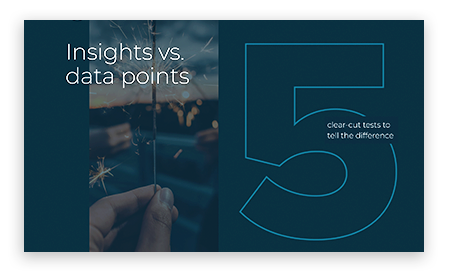Customer experience insights: How to get the full picture and drive real change
Published on Nov 22, 2022

If you’re measuring the customer experience (CX), you likely don’t have a shortage of CX data—but that data doesn’t do anything on its own. To really understand your business and drive customer loyalty, you have to be able to translate that data into actionable insights.
In this blog, we’ll answer a series of FAQs to unpack what a true customer experience insight is (vs. just a data point), why it’s important to make the distinction, and how to be sure that your business is getting them. We’ll also provide best practices for building + evolving an insights-driven program and additional resources you can access to further your CX research.

5 tests: Do your CX insights drive outcomes?
Defining true CX insight
It’s easy to conflate insights with data points—things that make you go “Mhm.” rather than “Aha!” The data can certainly point you in the right direction, but an insight tells you exactly what you’re seeing when you get there. It’s the difference between a signpost and a roadmap—between knowing where you are and knowing how you got there and where you need to go.
A true CX insight isn’t some lofty, abstract goal. It’s a tangible deliverable—one you should hold your XM provider accountable for.
To help determine if you’re getting true CX insights or simply collecting a bunch of data, use these tests for clear-cut criteria:
Test 1: Insight specificity
If needing specific information to take targeted action seems like a no-brainer, you’re right. That’s why it’s so surprising how many “insights” presentations and reporting tools focus on what’s happening without so much as a nod to next steps to take.
A true CX insight, on the other hand, presents timely information that details exactly what’s happening, why it’s happening, and how to enact change.
Why does it matter? Fluctuations in scores is barely a conversation starter—true CX insights add nuance by referencing industry knowledge, demonstrating client understanding, and putting disparate datasets in dialogue.
Test 2: Insight understandability
While specificity is key, be aware of format and intended audience to avoid burdening teams with unnecessary information. Deciphering detracts from doing—make sure every insight is presented in an intuitive format that clearly defines action items and responsibilities.
Field teams need solutions that are:
- Action-oriented
- Intuitive + engaging
- Easily accessible
Test 3: Insight prescriptiveness
So let’s assume your insight has passed the first two tests. It’s specific enough to identify a single, solvable issue and presented in an understandable format that focuses your efforts in the right areas. While that’s a great start, it’s not even half the battle. To truly affect organizational change, the insight has to prescribe a strategic plan of attack and define what those efforts will actually look like in the field.
Brands using CX data to build informed strategies have a lot of information to work with—but front-line teams don’t need to be bogged down in the data to be effective. If you want them to move a specific needle, you have to provide targeted coaching on which levers to pull.
Test 4: Insight measurability
It’s a lot easier to succeed when you know exactly what you’re trying to achieve. A corporate initiative with nebulous success criteria isn’t just hard to rally around—it can have an adverse effect on company morale once teams notice no one is even able to track whether their efforts are paying off.
By using internal and external benchmarks to understand how different areas of the business perform in comparison to one another, past performance, and industry averages, you’re able to build goal-oriented strategies.
In addition to providing a specific target to strive toward, tying front-line efforts to a measurable standard will likely inspire a spirit of friendly competition in the field—and make it that much easier for you to celebrate their wins.
Test 5: Insight value
If your insight has made it this far, it’s providing specific information in an engaging format that prescribes clear action items likely to produce measurable results. Sounds pretty good, right? But it’s still not enough. Because an improvement limited to one aspect of the customer experience is a bit like the proverbial tree falling alone in the forest. If no one takes notice, does it really matter?
The fact is, even though CX programs may live in one department, every role in your organization plays a critical part in shaping the entire customer journey.
Make sure your next insight:
- Predicts the accompanying financial outcomes
- Factors in omnichannel impact like call center volume + social ratings
- Produces results that extend beyond CX measures
CX tools for uncovering insights
There are a lot of options when it comes to XM program solutions—and it’s vital CX leaders take the time to evaluate those offerings and ensure they are the most intuitive and easy to use. The most successful programs have access to a portfolio that includes XM programs, analytics technologies, and reporting tools within a combined self-service and managed-service platform.
While there are dozens of tools to assess, here are the top 3 that should be on your radar:
1. Text analytics
By soliciting open-ended feedback, CX programs allow every customer to comment on any aspect of the business. Text analytics then turns those comments into insights by identifying emerging themes and breaking down customer sentiment.
Authentic customer feedback paints a clearer picture of everyday performance on things like operational metrics, marketing initiatives, and service standard execution. But just as powerfully, it can help you answer questions you never thought to ask.
2. Industry benchmarks
Some say you shouldn’t compare yourself to others. This may be true in your personal life, but when it comes to your business, if you don’t know where you stand, how can you begin to get better?
Brands that are unclear about what their competitors are doing are operating in the dark. Benchmarks shed light on the competition, providing benefits that will help you:
- Know where you stand vs. competitors + pinpoint where you can improve
- Uncover actionable insights to help find opportunities for meaningful change
- Identify gaps between top- + bottom-performing locations
- Drive sales + growth through operational, product, + service improvements
3. Real-time reporting
All of the data in the world doesn’t amount to much if it doesn’t reach the right people at the right time in an actionable format. CX programs provide 24/7 access to real-time data via reporting dashboards tailored to different roles—which means users across every level of your organization get exactly what they need to drive change.
Along with the reporting dashboard, users have a myriad of tools at their disposal, including:
- Mobile reporting apps to keep them up to speed while on the go
- Real-time alerts to track emerging issues from occurrence to resolution
- Powerful report builders to answer complex research questions
Building an insights framework
It’s easy to turn on an XM program and let it run—but advancing your program and hitting goals that drive business performance requires evolution over time and a commitment from the entire organization.
The first step in creating an impactful XM program is to establish a strong foundation, which can be accomplished by focusing on these areas:
Driving response rates
Focus on program visibility and adjusting invites and incentives if your responses are low. With a higher volume of data, you’ll boost confidence in the program.
Defining areas for focus
Areas for focus (AFFs) are the two biggest opportunities to impact customer satisfaction for each location or touchpoint. SMG calculates AFFs based on a regression model that’s part of our proprietary algorithm—taking into account current performance, previous performance, the national average, and appropriate weighting.
You should eventually migrate AFFs to a dynamic model, but to start, it’s best practice to define static AFFs so all teams are working toward the same objectives.
Increasing engagement
Increase company-wide engagement by incorporating action planning into your launch. Empower and encourage users to check on the data regularly. And be sure to share survey results directly with front-line teams.
Sharing insights across the business
Whether you’re kickstarting your first-ever experience management (XM) program or hitting refresh on your current one, your program’s success depends on buy-in and execution from various functional stakeholders across the organization.
To drive program engagement from the start, your team needs an air-tight communication plan. Here are 4 steps to solidify your comms strategy and ensure your program is built for long-lasting impact:
Announcing the program
Your program rollout is as big a deal as you make it. Be sure to communicate proactively at every level to articulate the important role this initiative will play in your company’s larger strategy. Plan out your messaging cadence so everyone in your organization is being properly notified prior to launch.
Engaging leaders
A truly effective program needs to cascade across the entire organization, with everyone in the company understanding early on how their role impacts the customer experience. To secure organizational buy-in, establish a cross-departmental steering committee.
Defining goals and objectives
With a program customized to your company’s culture and business needs, employees at every level will get a better understanding of how your plan of action impacts their role—and vice versa. A clearly defined XM program should feel like a tool that’s designed to synthesize efforts and aid everyone in doing their job.
Communicating with front-line
For front-line communications, make sure the message is as visual as possible, and keep it short, simple, and easy to remember. Distill the big data down to the most important actionable items they can start using immediately. To keep the messaging fresh, mix up your modes of communication according to their intended purpose.
Defining program success
Too often, CX programs get sidelined as performance-trackers or diagnostics tools—collecting data that doesn’t appear on a meeting agenda until something starts flashing red. Scores fluctuate, reports get skimmed—but by and large, it’s business as usual.
Before you know it, you find yourself on the wrong side of the growing gap between brands that are simply aware of the data and those that are using it to surface insights that drive action and produce meaningful business results.
To build your formula for success, answer these 3 ROI questions:
1. Is our CX data comprehensive enough to point us in the right direction?
Part of the reason ROI calculations get so convoluted so quickly is a simple case of missing variables. Brands measuring single touchpoints or operating in departmental silos lose sight of the big picture. So, while one team celebrates an uptick in conversion rates + on-site satisfaction, others scramble to address an influx of returns accompanied by overwhelmed contact centers and plummeting ratings + reviews.
To get a holistic view of the entire brand experience, organizations must map out the entire journey—from the customer’s point of view—and capture feedback at every juncture.
2. How do we translate the data into insights that lead to targeted action?
Let’s say your measurement strategy is on point and collecting high-quality data across every channel. While that’s a notable achievement, it’s not nearly enough. An ROI-centric CX program ensures you’re not just collecting the right data, but also getting it into the hands of the people tasked with acting on it.
And when it comes to something as all-encompassing and complex as the customer experience, those users need an intuitive analytics platform that:
- Describes what’s happening
- Diagnoses the root cause quickly
- Prescribes clear actions
- Predicts what results to expect
3. Do we have the expertise to connect CX improvements to actual business outcomes?
A true ROI-generating program isn’t about tracking today’s strategy—it’s about shaping tomorrow’s and ensuring you’re primed to evolve alongside customer expectations + behaviors. The most sure-fire way to future-proof your program and secure long-term investment is to:
- Show how it illuminates the right path forward by analyzing how CX results align with market trends
- Incorporate emerging technologies like AI-based analytics
- Connect every insight to a projected financial outcome
Unfortunately, time is limited, and even with ramped up investments, most CX teams remain lean. That’s why it’s important not to settle for just any CX vendor. Choose a partner that can deliver on all these things.
Additional CX insights resources
While this is a great start, it’s not a comprehensive list of all you need to know on CX insights and how to build an ROI-generating XM program. The good news is we’ve made further research very easy for you.
The SMG Resource Center is your instant access to 300+ pieces of content—ranging from client success stories and case studies to best practice guides, blogs, and more. The easy-to-navigate portal allows you to filter by industry, solution, topic, and content type, ensuring your search is customized to your needs.
Or, if you’re tired of all this reading, you are always welcome to reach out to us directly to request a demo of our CX solution or to just have a conversation with one of our CX experts. No matter where you are in our XM journey, we’re here to help!
Related articles

Power play: Unleashing the combined force of a unified customer and employee experience management strategy
Discover the power of integrating employee + customer experience data, and learn how prioritizing employee experience leads to engaged team members, loyal customers, + business success.

Demonstrating CX program ROI to leaders
Here are 6 steps customer experience leaders should take to maximize the return of their investments.

Why a personalized customer experience is the key to business success
In today's relentless business landscape, personalization in customer experience (CX) has evolved from a luxury to a vital necessity. In fact, 81% of customers prefer companies that offer a personaliz